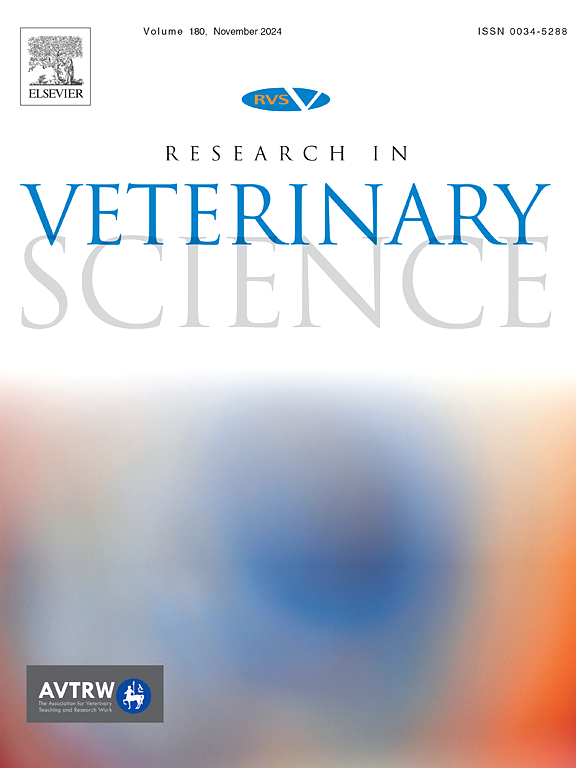Co-occurrence of leptospirosis and Opisthorchis viverrini infection in cats and their risk factors
IF 2.2
3区 农林科学
Q1 VETERINARY SCIENCES
引用次数: 0
Abstract
Leptospirosis is a waterborne disease with a worldwide distribution. In Northeast Thailand, its prevalence overlaps with the endemicity of Opisthorchis viverrini, (OV). This study aimed to investigate the prevalence and risk factors of leptospirosis in cats and its association with opisthorchiasis in endemic area of Thailand. 115 cats were sampled for blood and feces. We tested Leptospira antibodies in blood using the Lepto-latex test. For fecal analysis, we applied the formalin-ether concentration technique (FECT) for OV and identified Leptospira spp. through PCR targeting the 16S rRNA and LipL32. Non-spatial analyses included Pearson's Chi-square, Fisher's exact test, and logistic regression, while spatial analyses involved Inverse Distance Weighted (IDW), spatial autocorrelation, and Geographically Weighted Logistic Regression (GWLR). Serological analysis revealed 15.65 % of cats positive for Leptospira spp., whereas 44.35 % of fecal samples positive for OV. PCR analysis identified 1 L. interrogans with the 16S rRNA, while the LipL32 identified 2 samples related to L. interrogans and 1 to L. borgpetersenii. The spatial autocorrelation indicated clustering of leptospirosis cases. Logistic regression revealed 2 significant risk factors; OV infection (OR 3.44, 95 % CI 1.10–10.73; p 0.03) and proximity to flooded areas (OR 3.47, 95 % CI 1.12–10.74; p 0.03). Furthermore, GWLR showed median coefficients of 0.59 (−1.62–5.15) for OV infection and 2.15 (1.30–6.47) for proximity to flooded areas. This study demonstrates a significant association between cat leptospirosis with OV infection and proximity to flooded areas. These highlight the importance of monitoring environmental and biological risk factors to mitigate leptospirosis in endemic regions.
猫钩端螺旋体病与猪腹弧菌共发感染及其危险因素分析
钩端螺旋体病是一种水传播疾病,分布于世界各地。在泰国东北部,该病的流行与Opisthorchis viverrini(OV)的流行重叠。本研究旨在调查泰国流行地区猫中钩端螺旋体病的流行情况和风险因素,以及该病与弓形虫病的关联。我们对 115 只猫进行了血液和粪便采样。我们使用 Lepto-latex 试验检测了血液中的钩端螺旋体抗体。在粪便分析中,我们采用福尔马林-乙醚浓缩技术(FECT)检测 OV,并通过针对 16S rRNA 和 LipL32 的 PCR 鉴定钩端螺旋体。非空间分析包括皮尔逊卡方检验、费雪精确检验和逻辑回归,空间分析包括反距离加权(IDW)、空间自相关和地理加权逻辑回归(GWLR)。血清学分析表明,15.65%的猫对钩端螺旋体属呈阳性反应,而 44.35%的粪便样本对 OV 呈阳性反应。PCR 分析通过 16S rRNA 鉴定出了 1 例 L. interrogans,而 LipL32 鉴定出了 2 例与 L. interrogans 相关的样本和 1 例与 L. borgpetersenii 相关的样本。空间自相关性表明钩端螺旋体病病例具有聚集性。逻辑回归显示了两个重要的风险因素:OV 感染(OR 3.44,95 % CI 1.10-10.73;P 0.03)和靠近洪涝地区(OR 3.47,95 % CI 1.12-10.74;P 0.03)。此外,OV 感染的 GWLR 中位系数为 0.59(-1.62-5.15),靠近洪涝区的 GWLR 中位系数为 2.15(1.30-6.47)。这项研究表明,猫钩端螺旋体病与 OV 感染和洪水泛滥地区的邻近程度有明显的关联。这凸显了监测环境和生物风险因素以减轻流行地区钩端螺旋体病的重要性。
本文章由计算机程序翻译,如有差异,请以英文原文为准。
求助全文
约1分钟内获得全文
求助全文
来源期刊

Research in veterinary science
农林科学-兽医学
CiteScore
4.40
自引率
4.20%
发文量
312
审稿时长
75 days
期刊介绍:
Research in Veterinary Science is an International multi-disciplinary journal publishing original articles, reviews and short communications of a high scientific and ethical standard in all aspects of veterinary and biomedical research.
The primary aim of the journal is to inform veterinary and biomedical scientists of significant advances in veterinary and related research through prompt publication and dissemination. Secondly, the journal aims to provide a general multi-disciplinary forum for discussion and debate of news and issues concerning veterinary science. Thirdly, to promote the dissemination of knowledge to a broader range of professions, globally.
High quality papers on all species of animals are considered, particularly those considered to be of high scientific importance and originality, and with interdisciplinary interest. The journal encourages papers providing results that have clear implications for understanding disease pathogenesis and for the development of control measures or treatments, as well as those dealing with a comparative biomedical approach, which represents a substantial improvement to animal and human health.
Studies without a robust scientific hypothesis or that are preliminary, or of weak originality, as well as negative results, are not appropriate for the journal. Furthermore, observational approaches, case studies or field reports lacking an advancement in general knowledge do not fall within the scope of the journal.
 求助内容:
求助内容: 应助结果提醒方式:
应助结果提醒方式:


